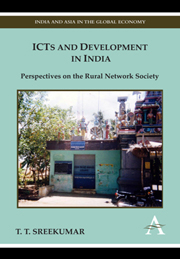Book contents
- Frontmatter
- Contents
- List of Figures and Tables
- Preface
- 1 Introduction: Exploring the Rural Network Society
- 2 Civil Society and Cyber–Libertarian Developmentalism
- 3 Decrypting E-Governance
- 4 Cyber-Kiosks and Dilemmas of Social Inclusion
- 5 Innovating for the Rural Network Society
- 6 ICT and Development: Critical Issues
- Notes
- Bibliography
- Index
3 - Decrypting E-Governance
Published online by Cambridge University Press: 05 March 2012
- Frontmatter
- Contents
- List of Figures and Tables
- Preface
- 1 Introduction: Exploring the Rural Network Society
- 2 Civil Society and Cyber–Libertarian Developmentalism
- 3 Decrypting E-Governance
- 4 Cyber-Kiosks and Dilemmas of Social Inclusion
- 5 Innovating for the Rural Network Society
- 6 ICT and Development: Critical Issues
- Notes
- Bibliography
- Index
Summary
Technology and Governance
The notion of ‘e-governance’, along with such other ‘epithetized phenomena’ as e-learning, e-banking, e-marketing etc. played a major role in shaping the futuristic e-topias of the global information society discourse. Woolgar (2002, 3) points out that ‘epithetizing’ various existing activities and social institutions with notions such as ‘virtual’, ‘digital’, ‘electronic’ (or simply ‘e’), ‘cyber’, ‘tele’ etc. helps to ‘conjure up a future consequent upon the effects of electronic technologies’. Given the backdrop of the increased involvement of new media technologies in delivering e-governance, it is important to understand the social and historical specificities of the emerging technological systems that facilitate the construction of the notion. It is also pertinent to take a closer look at the relativity of technical design and absorption into the culture and strategies of actors (Feenberg 1999) in order to discuss e-governance from a nonessentialist perspective. Social constructivism provides some provisional but meaningful theoretical foundations to look at e-governance in nonessentialist terms. One of the important conceptual endeavours to understand e-governance initiatives from a constructivist perspective would be to disaggregate the question of technology from the differential perspective of the dominant and subordinate subject positions of the actors involved. Arguably, e-governance projects are rationally planned and implemented by technocrats in an effort to exercise a far more effective control over resources and social organization. Nevertheless, common people encounter these technologies of systematization as part of their life world and appropriate, reject or force revisions in the designs as well as systems.
- Type
- Chapter
- Information
- ICTs and Development in IndiaPerspectives on the Rural Network Society, pp. 67 - 96Publisher: Anthem PressPrint publication year: 2011



